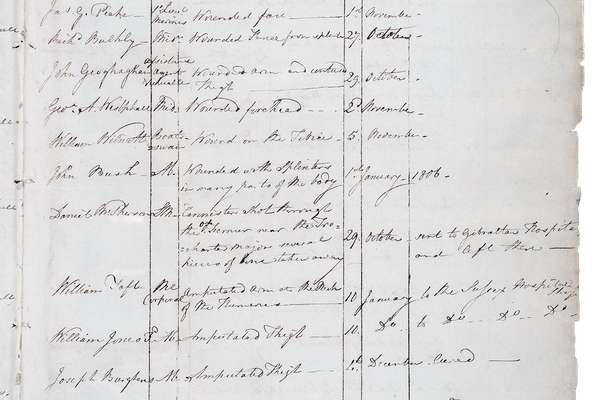In pictures
Hospital ships
Hospital ships have been receiving and treating wounded and sick sailors since the 17th century. Collections at The National Archives highlight the fascinating role that hospital ships have played in the provision of healthcare at sea.
Contract for creating hospital cabins on a vessel

- Date
- 5 April 1673
- Catalogue reference
- SP 46/137/795
Ships were first used as hospitals in the 1600s, though they were not common in the Royal Navy until the 18th century. There are some records relating to the use of ships for caring for the sick and wounded dating from the 17th century.
During this time, ships were not specifically built as hospital ships, but regular navy vessels were repurposed or adapted for the care of the injured or sick. References to such repurposed ships can be found in The National Archives’ collections, through letters which mention requests to modify vessels in the Royal Navy fleet.
This record relates to one of these early hospital ships. Found within the State Paper Office collections, it is a contract of tender to an Edward Salter, to convert a vessel for the purpose of sick care by building sick cabins on board.
Pay books of the hospital ship Blenheim

- Date
- 1 October 1746 – 19 May 1748
- Catalogue reference
- ADM 33/391
By the 1700s hospital ships were increasingly employed by the Royal Navy. Select ships were specifically used for the purpose of caring for the sick. Each one was staffed by surgeons, assistants, mates and – increasingly – female nurses.
The Blenheim was converted into a hospital ship in the mid-1700s. This large, three-decked ship was redeployed for the purpose of providing sick care when it was no longer sea-worthy, and placed in Portsmouth Harbour to cater to the crewmen at the local base.
The pay books of Royal Navy ships provide the names of the crew on board. They show who cared for the sick and injured, including the names and occupations of several women on the ship. The Blenheim’s list includes details of women employed as nurses and as washerwomen, as well as their wages. Such records provide us with evidence of women’s valuable role within the Royal Navy during the 18th century.
Medical and surgical journal of the cholera hospital ship HM Tremendous

- Date
- 1832
- Catalogue reference
- ADM 101/123/6
The medical and surgical journals of hospital ships provide day-to-day insights about injury and disease within the fleets of the Royal Navy. HM Tremendous was stationed off Sheerness where patients were received and treated by the ship’s surgeon, D Wright. His notes give details of the patients he treated between 4 and 21 August 1832. Among those treated was James Smith, a seaman from the ship Siberia.
James had collapsed on the previous ship and been transferred to the Tremendous for more attention. The medical journals provide interesting insights into the unique treatments that were administered to cholera patients. Among the treatments he received was a hot mustard bath. Mustard was applied to James’s feet, legs and abdomen whilst he was placed in a hot bath. Despite the attempts to revive him, the record indicates that James died of cholera shortly afterwards.
Inquiry into damage to the hospital ship Glenert Castle during the First World War

- Date
- 1917
- Catalogue reference
- ADM 137/3253
During the First World War, the Royal Navy employed hospital ships around the world to deal with large numbers of injured personnel. Many of these ships were repurposed cruise liners that could hold thousands of people at a time.
The ships were meant to be protected from attack by the Hague Convention of 1907, which stated under international law that hospitals could not be targeted. Hospital ships had to signal their status by presenting themselves according to certain rules. They had to be painted white, not grey or camouflaged, and have large, red crosses painted on the hull.
This record relates to a possible attack on a hospital ship in March 1917. The HMHS (His Majesty's Hospital Ship) Glenert Castle was damaged at sea and the file investigates possible illegal action against it. In this case the ship had hit a mine, but later in the war it was attacked and destroyed by German forces.
Plans of the Hygeia, hospital hulk of the Port of London Sanitary Hospital

- Date
- 1936
- Catalogue reference
- MT 15/1205
Records at The National Archives also illustrate how some ships delivered health services outside of the realm of the navy.
From 1922, a ship named the Hygeia was moored off the coast of Gravesend. Its purpose was to assist in the quarantining of seamen that had infectious diseases, on behalf of the Port of London Sanitary Authority. It housed the medical officers that inspected seamen for signs of diseases such as cholera, yellow fever and plague. The ship was used as a base from which medical inspections would take place before the potential patients were transferred to land.
Originally a wooden boat, it was replaced in the 1930s with a more up-to-date ship made of steel. These blueprints show the plans of the new ship, including accommodation for officers and plans of its ventilation systems – essential for maintaining a safe working environment.
Featured article
Record revealed
List of HMS Victory's killed and wounded at the Battle of Trafalgar

We hold one of the lesser known records from the Battle of Trafalgar, the Surgeon’s journal for HMS Victory by William Beatty.